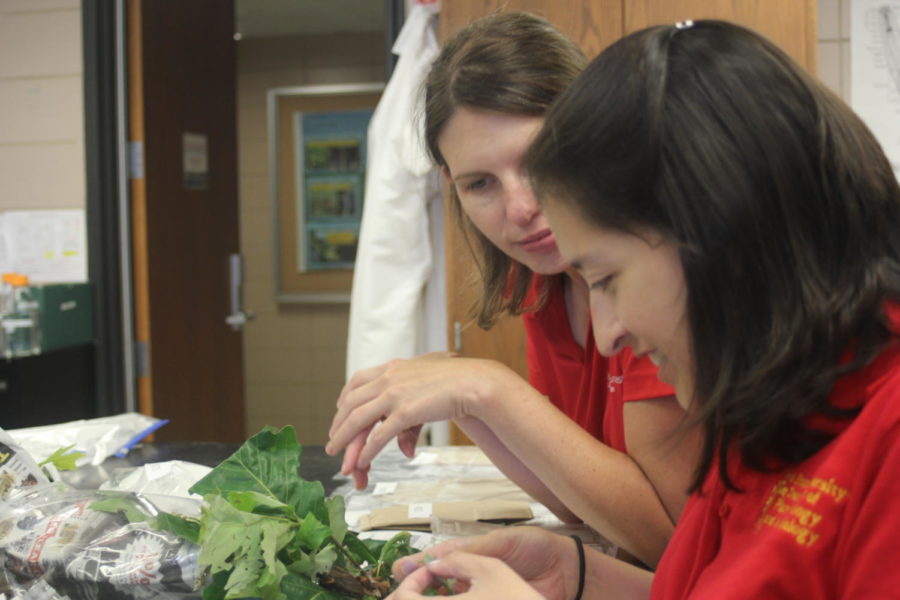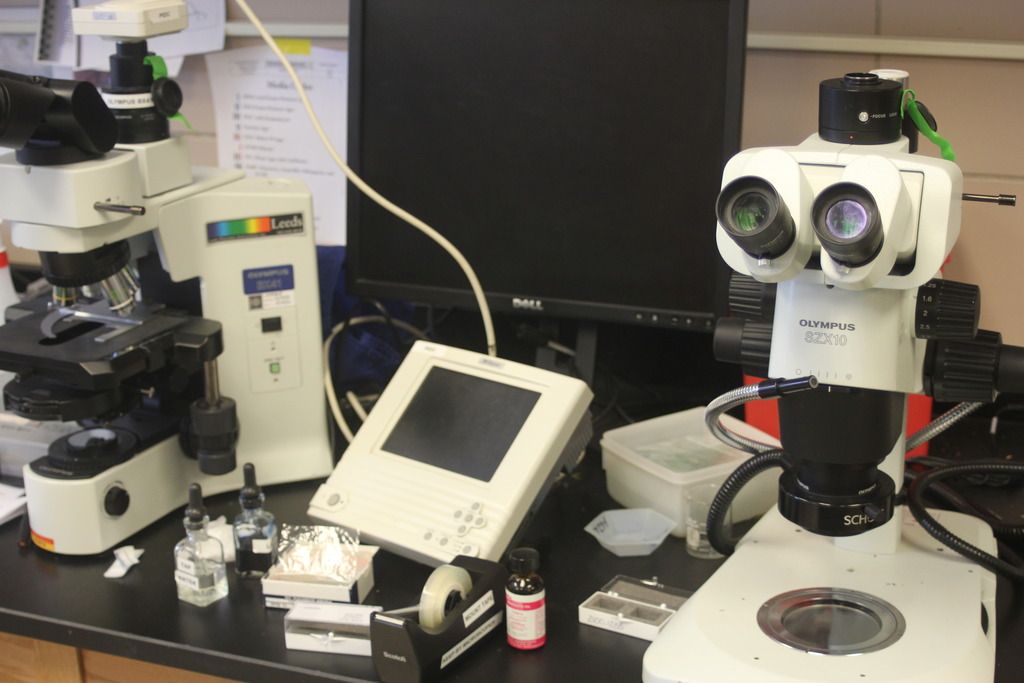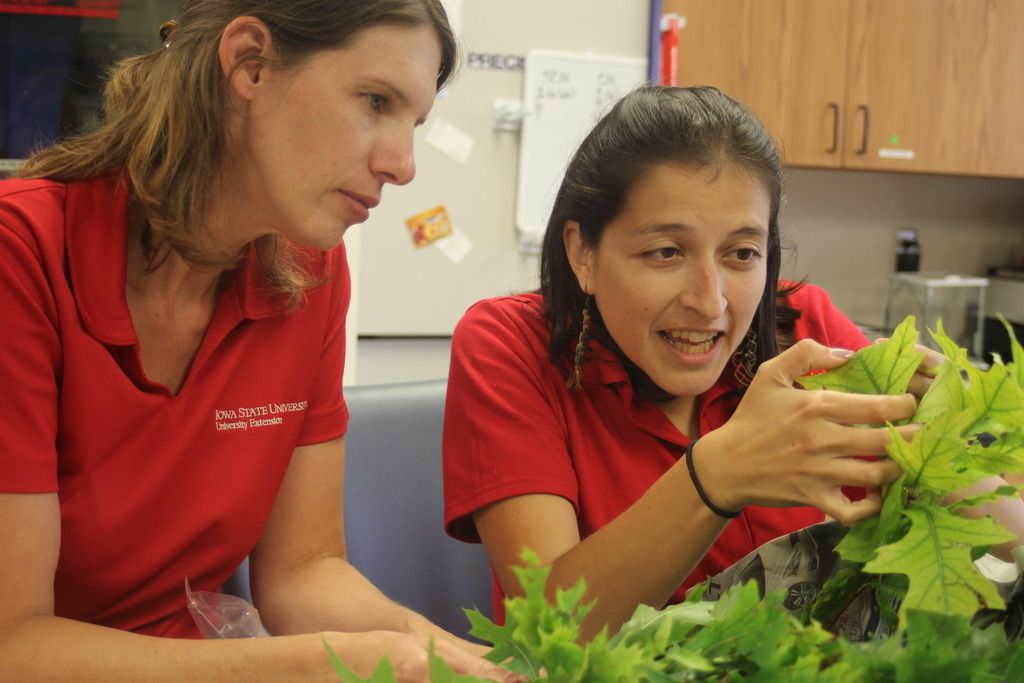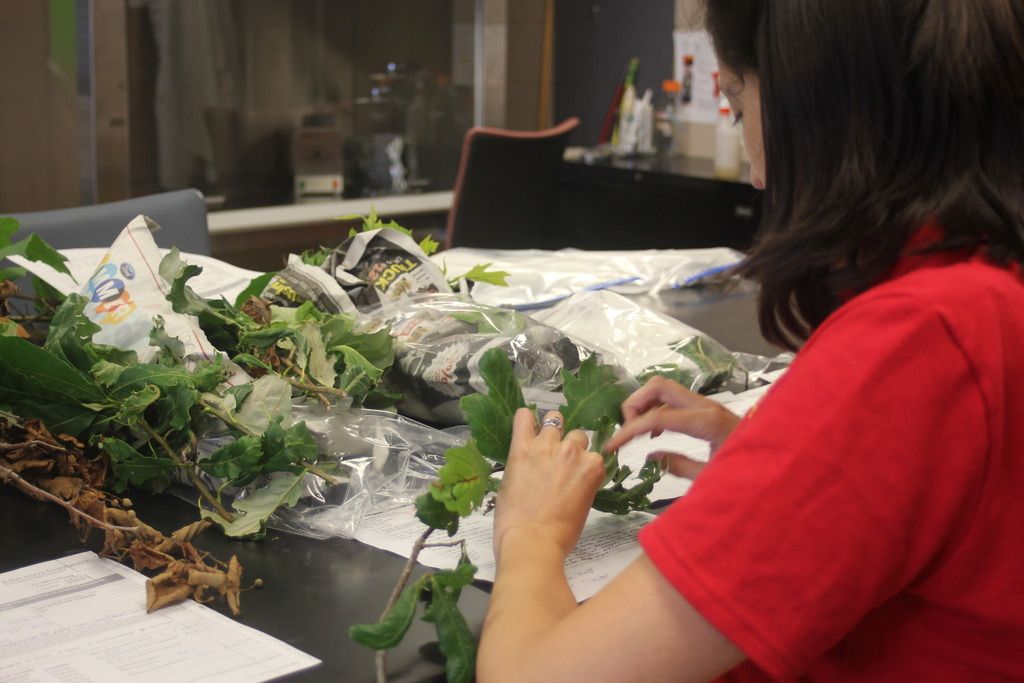‘Plant E.R.’ saving lives one leaf at a time
By Leah Landrum [email protected]
Laura Jesse and Lina Rodriguez Salamanca inspect a sample sent in by a client to the Plant and Insect Diagnostic Clinic.
July 31, 2015
The leaves of the oak trees were infected; lesions and dark spots littered their tiny structure. If it was oak wilt, it could be the death of the huge, old trees, and it could spread to other nearby oaks.
Local forester, Luke Gran, wanted to be sure his client’s trees weren’t being attacked by this deadly disease, and he didn’t want his clients paying hundreds of dollars to treat a disease the oaks might not even have.
He sent a sample in to the Plant and Insect Diagnostic Clinic at Iowa State, and after a week or two, the results were in. The oak tree did not, in fact, have oak wilt. It actually had oak anthracnose, which for a tree is much like the common cold for a human.
By involving the clinic, Gran was able to save his clients a lot of time and money, and he was able to give them the peace of mind that their beautiful oak trees would survive and continue to shade their home.
“When the people are very upset… you have to be the calm one that comes in and very scientifically addresses what’s going on,” said Daren Mueller, assistant professor and extension plant pathologist.
Laura Jesse, extension plant pathologist and director of the clinic, said her goal is for people to hang up the phone happier than they were when they called.
“They feel relieved [and] they feel like they’ve got the understanding,” she said.
Gran, who earned his bachelor degree in forestry from Iowa State in 2008, uses economic, ecosystem approaches to manage land for his clients, he said.
Gran said he sees the Plant and Insect Diagnostic Clinic as a huge resource, not only for himself, but also for the community.
“In ecosystems there are a lot of complicated things going on that sometimes stump even a well-trained forester like myself,” he said. “Anytime I’m stumped on what affliction is going on with the tree or an important crop for a farmer, I use the plant disease clinic as a really important resource to correctly identify the issue that’s going on.
“I can then take that precise knowledge to the landowner and give them an economic, efficient [and] clear… recommendation on how to proceed.”
The Plant and Insect Diagnostic Clinic provides two main services: IDs and diagnosis. The clinic can ID plants, mushrooms and insects and the diagnosticians look for the cause of problems in plants, such as nutrient issues or disease.
“I think the most important part of the work that we do is… if you know what is causing the problem, then you can take the right measures to reduce it and control it better,” said Lina Rodriguez-Salamanca, plant pathology diagnostician. “An accurate diagnosis can be the first step to management.”
Mueller said the goal is for the client to get the best, most unbiased and accurate assessment of what’s going on.
The clinic has been around since the 1970s, and for those who are aware of its existence, it has become a useful tool, but the staff has found that not many people actually know about it.
“This last year we did an assessment of the clinic and took a hard look in the mirror,” Mueller said. “We were sort of doing things as we always [had]… We were inefficient. Part of the findings were that a lot of people didn’t know about us. Just like with a lot of other things on campus, you are so busy doing your job, you don’t think about telling people that you’re doing your job.”
This started a process of trying to get the word out and making some much-needed upgrades to their system of doing things.
“We are really wanting to let people know that we are here. It seems like a bit of a well-kept secret, and people need to be aware that anyone can use our services,” Jesse said. “We’re not here for just professionals or growers; we’re here for students [or] anyone. If a student thinks, ‘Is this a bed bug?’ as they move into their apartment, [they can] bring it here. That’s what we’re here for.”
Not only can students use the clinic’s services for bug or plant related issues, but they can also get involved.
Salamanca said she hopes students know this can be a career opportunity, that plant doctors exist and agricultural jobs are booming.
Catie Irwin, a senior in microbiology, has worked in the clinic since May 2014, keeping items organized and tagged properly, isolating fungus or bacteria from plants and performing cultures.
She said the clinic is a service that students should use and tell their families about.
“They can utilize this more, whether it be for their family- letting their parents know if they have a dying tree in the yard, or if you have an insect in your apartment and you’re wondering if you need to get it sprayed,” Irwin said.
“I think that several of the students that have come through have gained valuable experience to help them get into grad school,” Mueller said. “I think you will probably gain an appreciation for how difficult it is to grow food or to grow plants.”
The clinic, or the Plant E.R., as it has been called, is a part of entomology, plant pathology, horticulture and agronomy, and the staff works closely with each department, Jesse said.
The clinic is also a part of the Integrated Pest Management program and the National Plant Diagnostic Network.
Funding comes from both of those areas, as well as university and extension money and user fees.
“We are trained here to diagnose problems that are common, but also to keep our eyes open with things that are moving in between states,” Jesse said. “There’s a lot of regulatory or invasive pests or diseases that we have to keep our eyes on.”
Samples sent in can also aid with giving current essential information to the general public.
“If we’re getting a bunch of samples in of some soybean disease, that helps me realize I need to write up a good article and make sure that people know that this is becoming a problem this year,” Mueller said. “If we see it for two-three years in a row, then I can start writing proposals to get funding to address some of that.”
Samples can be sent in to the clinic physically or digitally. A large percent of what the clinic receives are photos sent digitally.
“We do treat the samples a lot like you would think an ER would,” Mueller said. “There is confidentiality; there is a due process: when the samples come in, you tag it, you label it, it stays with that label the whole time [and] it gets entered into the NPDN network.”
The clinic’s staff are excited for the future bio-science building, the Advanced Teaching and Research Building.
“We’re very excited about pulling in more modern diagnostic techniques like molecular techniques for diagnosing things,” Jesse said. “The new clinic in the ATRB building will allow us to start using diagnostic methods that are more accurate and fast.”
Through diagnostics, extension and outreach, the clinic wants to improve the health and lives of citizens of Iowa based on the research performed by Iowa State, Salamanca said.
Staff from the clinic will be at the Iowa State booth at the Iowa State Fair this year, she said.
“We’re going to be at the ISU booth [to] increase awareness that we’re here to help the citizens of Iowa,” Salamanca said.
With all of the services offered to professionals and the general public, Gran said he wishes the clinic were easier for the public to access.
“It’s such an important service,” he said.











